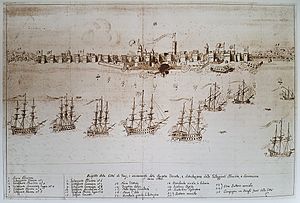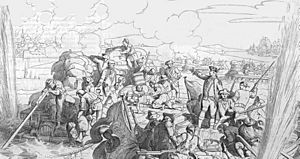Venetian bombardments of the Beylik of Tunis facts for kids
Quick facts for kids Venetian bombardments of the Beylik of Tunis |
|||||||
|---|---|---|---|---|---|---|---|
| Part of the European conflicts with the Barbary states | |||||||
 A contemporary sketch of the bombardments in 1784 |
|||||||
|
|||||||
| Belligerents | |||||||
| Commanders and leaders | |||||||
| Strength | |||||||
| Various tall ships 2 bomb ketches 9 bomb rafts |
Coastal defences Naval batteries Several ships |
||||||
The Venetian bombardments of the Beylik of Tunis were a series of attacks by the Venetian navy on the capital city and other port towns of the Beylik of Tunis. The goal was to make the ruler, Bey Hammuda ibn Ali, agree to a treaty again. This treaty would protect Venetian ships from attacks by Barbary pirates. The main part of this conflict lasted from 1784 to 1786. During this time, the Venetian navy, led by Angelo Emo, bombed many Tunisian harbor towns. The fighting continued until 1792, but there were no big naval battles after 1786.
Contents
Why the Conflict Started
War began between the Beylik of Tunis and the Republic of Venice because of a ship. A Venetian merchant ship, carrying goods from the Barbary coast, was burned in Malta. This happened because the ship was thought to be infected with the bubonic plague, a serious disease.
The Bey of Tunis demanded money for the burned ship, but he did not get any. He also asked for a larger yearly payment from Venice, but this was ignored. Because of this, the Bey declared war on Venice. Venice then chose a skilled admiral named Angelo Emo to lead their navy against the Bey.
Battles in 1784
Admiral Emo's fleet left Venice on June 21, 1784. It slowly sailed to Corfu, where more ships joined them. The fleet included large warships like the Fama and Forza, smaller ships called xebecs, and special "bomb-vessels." These bomb-vessels were ships designed to fire heavy bombs.
On August 30, Emo's fleet arrived near Tunis. Bad weather kept them from moving for three days. On September 3, the Venetian ships found and recaptured a small merchant ship that had been taken by Barbary pirates.
Emo left some ships to block the harbor of La Goulette. He then moved the rest of his fleet north. Later, he sailed to Sardinia to get fresh water. After that, the fleet went south and anchored near Sousse on October 1. Bad weather again delayed their plans. However, from October 5 to 7, Sousse was bombed by the Venetian ships. The bomb-vessels had some problems with their equipment. The attack was stopped, but it started again briefly on October 12.
After this, Emo went to Tripoli. The bomb-vessels were sent to Trapani in Sicily for repairs. One of Emo's ships, the Forza, sank in bad weather when entering Trapani harbor on November 19. Luckily, most of the crew survived.
Battles in 1785
In January 1785, two smaller Venetian ships sailed towards Tunis. One of them, the Nettuno, was almost destroyed near Palermo. Admiral Emo continued to move his fleet around, trying to negotiate with the Bey, but without success.
Attacks on Sousse and Sfax
Emo's fleet returned to sea in July. They sailed to Sousse with ships like the Fama, Eolo, and Concordia, along with bomb-vessels. They arrived on July 20. Bad weather again caused problems, but the bomb-vessels fired at the city on several nights in July and early August. They caused a lot of damage, firing over 400 large bombs.
On August 6, Emo left Sousse and moved south to Sfax. He reached Sfax six days later and bombed it on August 15 and 16. The results were similar to Sousse. After this, he sailed back to Trapani, arriving on September 1.
Attack on La Goulette
At Trapani, Emo's fleet received many new ships from Venice. These included the Sirena and the Vittoria. With his stronger fleet, Emo left Trapani on September 16. He arrived off La Goulette, the port of Tunis, on September 22. He tried to negotiate again, but the Tunisian government was not willing to talk.
Emo had a clever idea: he built two special rafts from barrels and spare parts. Each raft had one of his heaviest guns mounted on it, protected by sandbags. He also put a howitzer (a type of cannon) on a longboat. With these rafts and his bomb-vessels, he attacked the forts of La Goulette and two Tunisian gunboats on October 3 and 5. After a break for bad weather, the other ships joined for a final attack on October 10. They caused much damage on shore, and one Tunisian gunboat was disabled. However, the Bey still refused to give in. Emo then sailed to Malta.
The Venetian ships continued to patrol the area, trying to protect trade and capture Tunisian ships. Emo also tried to send letters to the Tunisian government to restart talks, but nothing worked.
Battles in 1786

Since his rafts had been useful, Emo built more of them. He made three rafts with two guns each and six with one gun. On February 26, 1786, he left Malta with most of his fleet. On March 12, he anchored off Sfax. The rafts were prepared, and on March 18, they slowly moved into position. The water was unexpectedly shallow, so the bomb-vessels could not get as close as before. However, on the evening of March 20, they began to fire. The results were not perfect, but Emo realized that firing bombs high into the air was more effective than direct shots. So, he began building a new raft to carry a large mortar (a type of cannon that fires bombs high up).
There was a long pause due to more talks with the Bey and bad weather. It was not until April 29 that they could continue. On the mornings of April 30 and May 4, two strong bombardments took place. After this, most of the rafts were taken apart. With a final effort on May 6, the fleet prepared to leave.
Attack on Bizerta
The fleet left on May 8 and reached Malta on May 24. After getting supplies, the fleet sailed again on July 4, heading for Bizerta. The journey was slow, taking twenty days to travel less than 250 miles. Upon arrival, eight rafts were prepared. These included two "bomber" rafts, one with two howitzers, and five with two guns each. There were also two longboats with howitzers.
The first bombardment on July 30 was done only by the bomb-vessels because the sea was too rough for the rafts. Emo said the results were "not very successful." However, the enemy's 145 shots also did not cause much damage. The next night, the longboats started the attack in the dark, and the bomb-vessels joined at dawn. This time, the attacks were more successful. Even though the shore guns had a surprisingly long range, the attackers suffered very little. On August 1, the weather was bad, and the mortars had to be removed from the rafts. But they were able to bomb again on August 3 and 4. On August 6, there was another attack. After that, the rafts were taken apart, and on August 10, the fleet left. They went to Favignana for water and reached Malta on August 22.
Final Attack on Sousse
After a short stay, Emo sailed again on September 4 with most of his ships. This time, they planned to attack Sousse. The fleet arrived there on September 19. The rafts, six with guns and two with mortars, were put together the day before. They were placed with the bomb-vessels and four shell-boats behind the main line of ships, waiting for the right moment.
For a week, nothing could be done. But on the evening of September 26, the rafts and small boats were moved into position. That night and for the next three nights, they fired for two or three hours. There was very little return fire from the shore. On October 3, the attack continued under bright moonlight. This allowed the shore guns to cause some damage and a few injuries. After this, the bomb-vessels rested. The final bombardment on October 5 was carried out only by the rafts and boats.
On the night of October 7, the fleet pulled back. The bomb-vessels went straight to Malta. The main fleet stayed at sea for some days before arriving on October 26. They stayed in harbor until December 7.
End of Major Battles
These attacks caused a lot of damage and injuries in the Tunisian cities. They also kept the Tunisian pirate fleet stuck in its harbors. Admiral Emo became famous across Europe for his exciting night bombardments.
However, it became clear that bombing towns would not make the Tunisian government agree to a peace treaty. Emo asked for a large army of 10,000 men to capture Tunis, but the Venetian Senate (the government) said no. Venice, like other European naval powers, preferred to make agreements with the pirates, even if it meant paying them yearly. This was seen as cheaper than a long and costly war to completely get rid of them.
The Senate decided to leave only a small force to protect trade and capture Tunisian ships. They called most of the fleet back home. Emo left Malta on March 18, 1787, and reached Corfu on April 6. His two bomb-vessels had already returned to Venice.
What Happened Next
Admiral Emo's departure mostly ended the active fighting. Another admiral, Tommaso Condulmer, stayed on patrol for the next five years. A peace agreement was finally reached in 1792. Condulmer's actions mostly resulted in capturing a few small ships and keeping the Tunisian navy stuck in its ports.
In 1791, the Venetian government decided to show its strength one last time. They brought together Emo's fleet and Condulmer's squadron. This combined fleet met in Sicily in August. It included many large warships, frigates, and smaller boats. Condulmer sailed towards Tunis on August 28, and Emo followed in September. They patrolled the Tunisian coasts while peace talks continued. On December 1, the whole fleet entered Malta for the winter. Admiral Emo died there on March 1, after a long illness.
Sources
- Anderson, R. C. (1952). Naval Wars in the Levant 1559–1853. Princeton: Princeton University Press. OCLC 1015099422. https://hdl.handle.net/2027/mdp.39015005292860.
- Preto, Paolo (1993). "EMO, Angelo" (in Italian). Dizionario Biografico degli Italiani, Volume 42: Dugoni–Enza. Rome: Istituto dell'Enciclopedia Italiana. http://www.treccani.it/enciclopedia/angelo-emo_res-b26e58d3-87ec-11dc-8e9d-0016357eee51_(Dizionario-Biografico).

